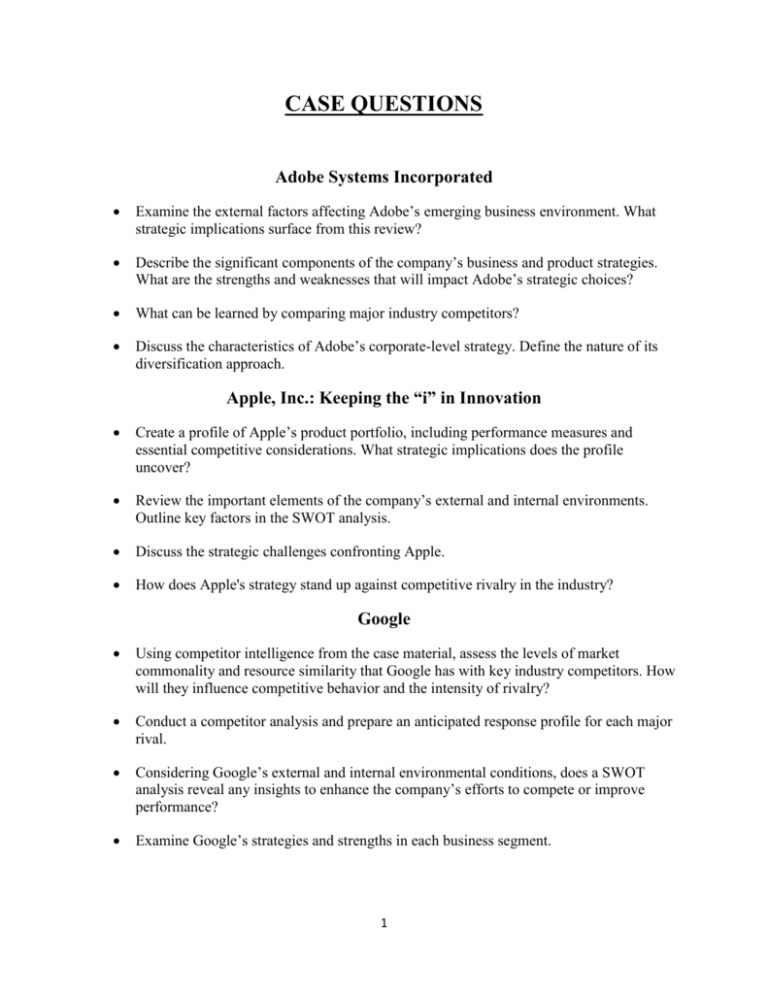From Big Mac to P`tit Plaisir
advertisement

CASE QUESTIONS Adobe Systems Incorporated Examine the external factors affecting Adobe’s emerging business environment. What strategic implications surface from this review? Describe the significant components of the company’s business and product strategies. What are the strengths and weaknesses that will impact Adobe’s strategic choices? What can be learned by comparing major industry competitors? Discuss the characteristics of Adobe’s corporate-level strategy. Define the nature of its diversification approach. Apple, Inc.: Keeping the “i” in Innovation Create a profile of Apple’s product portfolio, including performance measures and essential competitive considerations. What strategic implications does the profile uncover? Review the important elements of the company’s external and internal environments. Outline key factors in the SWOT analysis. Discuss the strategic challenges confronting Apple. How does Apple's strategy stand up against competitive rivalry in the industry? Google Using competitor intelligence from the case material, assess the levels of market commonality and resource similarity that Google has with key industry competitors. How will they influence competitive behavior and the intensity of rivalry? Conduct a competitor analysis and prepare an anticipated response profile for each major rival. Considering Google’s external and internal environmental conditions, does a SWOT analysis reveal any insights to enhance the company’s efforts to compete or improve performance? Examine Google’s strategies and strengths in each business segment. 1 McDonald’s: From Big Mac to P’tit Plaisir Describe the types of market demands that compelled McDonald’s to deviate from its successful business model. What actions did McDonald’s take in response to these market demands? Evaluate the effect or outcome of the company’s strategic actions. Provide evidence of their success or failure. Assess McDonald’s actions to demonstrate its sense of corporate responsibility. Has the company achieved the intended results? Microsoft Corp. Evaluate the external environment to identify the greatest opportunities and threats facing Microsoft at this time. Are conditions favorable for the company? What does a competitor analysis reveal about Microsoft’s major rivals? Discuss the strategic impact of competitive rivalry in each of the company’s business segments. Assess Microsoft’s internal environment and financial performance to define the company’s strengths and weaknesses. Which factors are the most critical for addressing the current situation? Summarize the key strategic challenges confronting Microsoft and identify suitable options for consideration. The Movie Exhibition Industry: 2010 Review trends in the general environment that affect the movie exhibition business, and establish their potential to help or harm theater owners. Assess the five competitive forces at work in the industry environment. Which of the forces threatens the profitability of major movie theaters? What level of competition can be anticipated among industry rivals? Perform a comparative situation and strategy analysis of the four companies with dominant market share. What are the advantages and disadvantages for each of the industry’s top competitors? Evaluate the revenue sources and major costs for exhibitors. Discuss how the income structure impacts their financial results. 2 Netflix Review Netflix’s organizational strengths. What core competencies have led to the company’s remarkable success? Under new industry conditions, will they qualify as sustainable competitive advantages? Can anything be done to lengthen or strengthen the advantage(s)? What are the greatest external risks facing the company? What measures can or should Netflix take to protect itself from these environmental threats? Evaluate the strengths, weaknesses, and strategies of the company’s primary competitors. Based on a thorough competitor analysis, what is the expected strategic intent of Netflix’s key rivals? Is the company prepared to respond to their potential competitive moves? Review cooperative strategies that have been used successfully by Netflix and its competitors in the past, then identify a set of goals that future partnership agreements should achieve to maintain the company’s position of market leadership. Porsche Using a SWOT analysis framework, evaluate the factors in Porsche’s internal and external environments. Be sure to specify strengths, weaknesses, opportunities, or threats that are new to the company as a division of Volkswagen Group. Review the mix of products offered under the Porsche brand. How do the models compare against competitor products in the marketplace? How will Porsche’s strategy change under Volkswagen ownership? What does this mean for the future of the company? 3 The Entrepreneurs at Twitter: Building a Brand, a Social Tool, or a Tech Powerhouse? Identify primary stakeholders who are impacted by Twitter’s strategic decisions and actions. Describe the expectations of each stakeholder group and whether proposed business models satisfy these expectations. Assess Twitter’s leaders along critical dimensions of strategic leadership. What does this assessment reveal about the needs of the organization? If a good business strategy is designed to gain a competitive advantage using the company’s core competencies, how do Twitter’s capabilities suit the business strategies under consideration by the company’s management? Summarize the most troublesome risks facing Twitter. What steps should be taken to minimize these risks, meet the strategic needs of the organization, and help reach its stated growth objectives? The Ultimate Fighting Championship and Cultural Viability Discuss the tactics employed by the Fertitta brothers and Dana White to legitimize mixed martial arts as a sport. What lessons were learned that could apply to an international expansion strategy? Considering the history of the UFC and the challenges that cultural differences present to sports-related organizations abroad, can Lorenzo Fertitta make a case for the UFC’s cultural viability in China, India, and/or South Korea? Should Fertitta move forward with pursuing these international locales for live PPV events, or is it best to continue holding events where there is a large fan base already? What tools are at the UFC’s disposal for implementing an effective international expansion plan? 4




